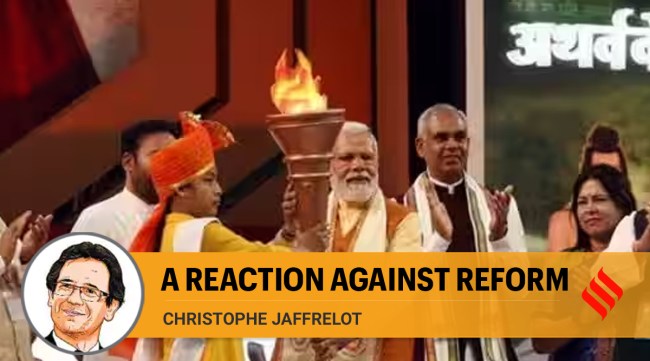Opinion Christophe Jaffrelot writes: How Sanatan Dharma was used to defend caste, combat Hindu reform
It was formed as a reaction against those who were in favour of social reforms
 During the 1906 session of the Hindu Samaj, Malaviya got a project of the Hindu University — which was to become the Banaras Hindu University (BHU) — approved. (Express File Photo)
During the 1906 session of the Hindu Samaj, Malaviya got a project of the Hindu University — which was to become the Banaras Hindu University (BHU) — approved. (Express File Photo) If Sanatan Dharma is without beginning and without end, its main organisation, the Sanatan Dharma Sabha is not — and not that old. It was formed in the 19th century by traditionalists reacting to their co-religionists from the Arya Samaj who then refused to appear as “Hindus” in the Census and were in favour of social reforms, including Dalits’ “purification” (Shuddhi), that Sanatanists rejected. The subtext of Sanatan Dharma, for them, was the defence of caste hierarchy.
The first architect of this ideology was Din Dayalu, who federated the Sanatan Dharma Sabhas he had created across North India into the Bharat Dharma Mahamandal (The Great Circle of the Dharma of India) in 1887, in Haridwar. Din Dayalu also launched an organisation whose name was a programme in itself: The Gau Varnashrama Hitaishini Ganga Dharma Sabha (The Religious Association for the Benefit of the Cow, Varna Order, and the Holy Ganges). He considered the restoration of the varna vyavastha as necessary for social harmony and believed in caste hierarchy: For the first session of the Bharat Dharma Mahamandal, he invited only Brahmins, Kshatriyas and Vaishyas, leaving out the Shudras and the Dalits.
Education was a priority for the Sanatanists. In 1899, Din Dayalu opened a Hindu College in Delhi but the main Sanatanist institution was the Banaras Hindu University founded by Madan Mohan Malaviya, a close friend of Din Dayalu.
To understand the ideology of the Sanatanists, which was more than conservative and reactionary, there is no better entry point than Madan Mohan Malaviya, the principal opponent of Motilal Nehru in Allahabad, who founded many institutions in the United Provinces of Agra and Oudh, including the Hindu Samaj, an archetypal Sanatanist organisation.
Born in a Smarta Brahmin family, Malaviya was given a modern education at Muir College and became a journalist and a lawyer. A member of the Congress since its inception, he got himself elected to the Municipal Council of Allahabad and then to the Provincial Legislative Council. But Malaviya was an archetypal orthodox Brahmin who did not accept food from any person who was not a member of his own jati.
During the 1906 session of the Hindu Samaj, Malaviya got a project of the Hindu University — which was to become the Banaras Hindu University (BHU) — approved. This text opened with remarks on the decadence of Indian society that Malaviya attributed to the decline of traditions, including the Varna vyavastha. He aspired to restore a social system founded on hereditary social functions on the model of the Vedic antiquity when “the interests of social prosperity were provided for by assigning different functions of human society to different classes, whose duty and interest it was to perform these functions efficiently and hand down their knowledge, talents, skill and aptitude to their descendants (…) The functions thus assigned to each class as its jatidharma were specialised by different families as their kuladharmas and were faithfully and efficiently performed for the well-being of the whole society, which was thus served by the classes and families composing it, as an organism is served by its constituent organs”.
This metaphor of the body calls to mind the Virat Purusha whose sacrificial dismemberment, as described in the Rig Veda 10.90, resulted in the making of the caste order, where the Brahmins originated from the head and the Shudras from the legs.
Not only did Malaviya argue in favour of the restoration of the varna vyavastha that was described in the oldest Vedic text, but his supporters were all conservative notables. The first project of the Banaras Hindu University had been debated in 1904 at a meeting presided over by the Maharajah of Banaras. It then took 10 years for Malaviya to find a site and to collect the funds, from people like Sukhbir Sinha who led the Zamindars’ Association and Raja Rampal Singh of Kurri Sidhauli (a taluqdar, whose money-lending activities were very lucrative, and who dominated the British India Association of Oudh, the organisation of the taluqdars of this sub-region of the United Provinces).
These notables were against the social reforms sponsored by the Arya Samaj. They resented the way this organisation promoted the Shuddhi movement that was intended to “purify” Dalits. For them, this artificial questioning of the eternal (Sanatan) social order was contrary to the Dharmashastras, including the Laws of Manu, scriptures which needed to be observed literally.
If Uttar Pradesh was the crucible of Sanatanist organisations, and if the defence of a caste-based social order was their main objective, there were Sanatanists elsewhere too — who focused on other issues. In the Bombay Presidency, at the end of the 19th century, the public scene debated a lot about the issue of legislating on the age of consent for the consummation of marriages. While reformers, including Jyotirao Phule, were in favour of such a law, Vishvanath Narayan Mandlik believed that child marriage should continue because the Shastras allowed such practices.
Soon after the opening of the Banaras Hindu University, M M Malaviya was instrumental in relaunching the Hindu Mahasabha in 1922. Ten years later, he represented the orthodox Hindus in negotiations with Ambedkar that resulted from Mahatma Gandhi’s fast unto death against the Communal Award: He was the Sanatanist voice in the Poona Pact.
Subsequently, the son of Din Dayalu, Mauli Chandra Sharma, became the second president of Jana Sangh (the matrix of the BJP) and M M Malaviya was posthumously awarded the Bharat Ratna in December 2014.
Jaffrelot is a senior research fellow at CERI-Sciences Po/CNRS, Paris, professor of Indian Politics and Sociology at King’s India Institute, London



